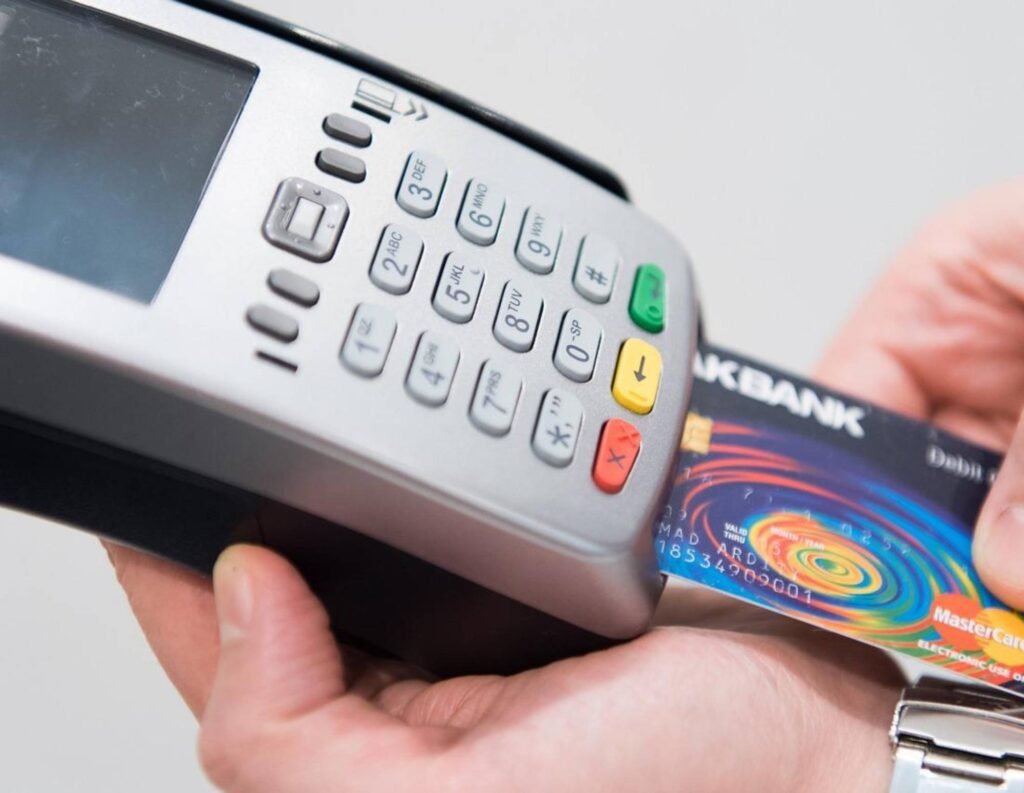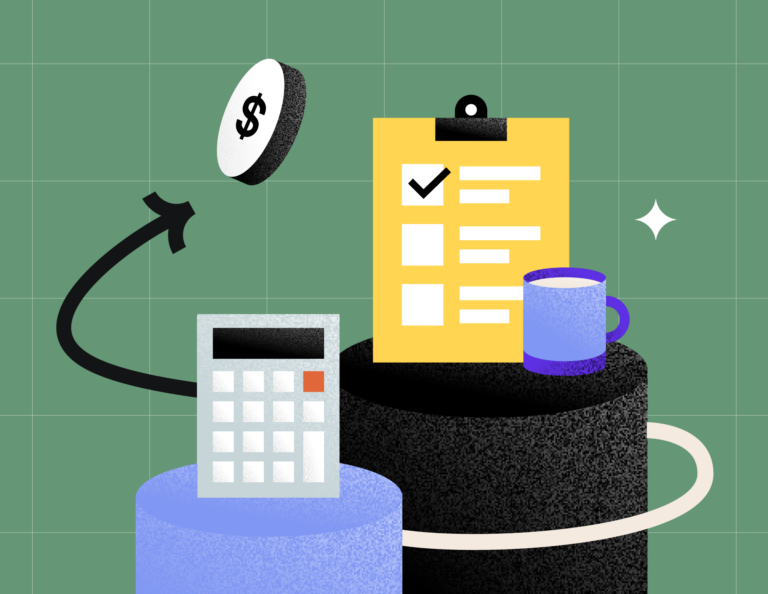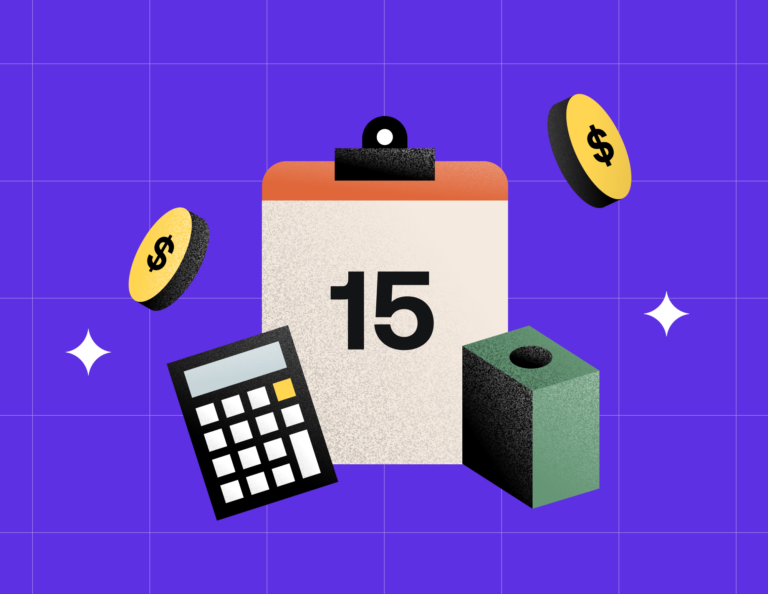Learn everything you need to know about payment processing, specifically for service-based independent businesses. Find out how to accept payments online, select the right processor, and get set up.

Whether you run a small business entirely online or in-person, you will need a way to securely collect and process payments from your clients. Many business owners think that accepting cash and checks is the best way to go–you don’t have to set anything up, and you can accept payment faster. Right? Not necessarily. These days, your clients accept secure online payment options, which enable them to pay you quickly.
If you haven’t already set up a process for collecting payments, now is a great time to explore your options for online payment processing. With this guide, you can learn everything about what it means to accept online payments and how to get started.
Jump to:
- What is small business payment processing?
- How does online payment processing work?
- Online payment portals
- How to set up payment processing for a small business
- Payment processing best practices
- Invoicing and payment processing on one platform
What is small business payment processing?
Quickly and accurately processing client payments has a positive effect on any independent business’s cash flow. To do so, you need online payment processing. As long as it accepts payments, any business can use an online payment company to process its client’s invoice payments. This is easy and convenient for both the business and the client.
Whether you provide your services in person or online, you can securely process your clients’ payments by using online payment processing software. Secure Sockets Layer (SSL) encryption and other security measures, such as compliance with the Payment Card Industry Data Security Standard, will ensure that payments are processed in a secure manner. That way, your clients’ payments are sure to transfer properly and with minimal risk.
Once you have a payment processor, clients can pay their invoices quickly and easily using your online payment portal. From the point of view of your client, using this online payment portal is practical because they can pay their bill however they prefer (credit card or ACH transfer) and can view their due payments from one place. An online payment portal also enables clients to make their payments on the go, wherever they may be, from their mobile devices.
How does online payment processing work?
If you allow multiple online payment options, your clients will appreciate the flexibility and the option to pay your invoices more quickly. Here’s how payment processing works for both credit card payments and ACH transfers.
Credit card processing
Credit card processing is essential for small businesses, as many consumers prefer to use cards to pay for their products and services. Our survey, courtesy of a partnership with Visa, found that 80% of respondents prefer to pay for their services with a credit card. To ensure you’re meeting expectations, it makes sense to accept credit cards.
An online portal requires accounts from both the client who wants to pay for services on the portal as well as the merchant. If you’re using an online payment processor like HoneyBook, the payment gateway and merchant account are already integrated. All you would need is an account with HoneyBook to start accepting payments from clients.
Related Post
What to expect from credit card processing fees
ACH transfers
Automatic Clearing House (ACH) transfers, also referred to as electronic funds transfers (EFTs), are similar to paper check payments except that the transaction is completed electronically. The fees for ACH transfers are typically a flat fee of $0.20 to $1.50 or a percentage fee of up to 1.5%, making ACH payment processing an inexpensive payment option compared to some credit cards.
This is how ACH transfers work:
- The client will input their bank account number and their bank’s routing number, authorizing a payment transfer.
- The deposit will be batched with other ACH payments to go through the ACH network.
- An ACH operator will receive and sort the deposits, then make the funds available to your bank.
- Once the funds are received, your bank will send confirmation to the originating bank that the transfer was successful.
An ACH transfer is more secure than credit card processing because the payment first passes through a clearing house that is bound by regulations governing the confidentiality and security of account numbers. In contrast, credit card payments are added to the client’s line of credit and are subject to a later due date with interest charges on balances due.
Related Post
How does payment processing work?
Online payment portals
An online payment processing company can generate an online payment portal, which allows clients to quickly and easily pay their invoices. From your client’s point of view, using an online payment portal is beneficial because they can pay their bill however they like and can track the status of their payment.
If you accept a range of online payment options, your clients can pay your invoices more quickly, which can help your cash flow.
Clients are commonly charged a transaction fee when their payment is processed in exchange for securely facilitating payments and granting access to the payment platform. Payment portal rates for merchants are typically between 1.4% and 3.5% per transaction, with monthly fees for some of the portals.
In the process of online payment:
- Both the client and the merchant sign up for accounts on the online portal website.
- When clients use a debit card to make a purchase, money is transferred instantly from the client’s account to the business’s account.
- When a client uses a credit card to make a payment, the payment is issued by the credit card company’s bank.
- The payment processing company verifies the credit card, and the issuing bank approves the transaction.
- EFT/ACH transfers are also an option.
- The client gets a receipt from the payment portal after the payment goes through.
Examples of online payment processors
When choosing a payment platform, consider your goals and priorities, which may include budgeting for fees, good customer service, or conveniences like managing multiple parts of your clientflow in the software.
Related Post
What is the best payment processor for small business?
1. HoneyBook
HoneyBook is a payment portal, invoicing tool, and clientflow platform. With this payment processing and business management platform, you can write and send legally compliant contracts and accept multiple forms of payment, including credit cards and ACH transfers.
Create and send invoices that you can also edit and manage on the go via the HoneyBook app. You can also set your HoneyBook invoices to specific payment schedules and methods, including recurring invoices and automatic payments. HoneyBook also offers some of the most competitive payment fees in the industry, helping you keep your expenses low. Along with payment processing, your entire booking process can be handled on HoneyBook.
If you use a hands-off booking process, HoneyBook’s unique and interactive files can help you streamline everything. Simply combine your invoicing and payment processing with other actions, like contract signing or scheduling. Your client will receive a single file with booking actions on each page, allowing them to move forward with you when they’re ready.
Best for:
- Freelancers
- Service-based businesses
- Creative professionals (e.g., photographers, designers)
- Small businesses needing integrated client management and invoicing
Pros:
- Integrated invoicing and payment processing
- Customizable payment schedules (including recurring and automatic payments)
- Competitive payment fees
- Streamlined client booking process
- Mobile app for managing invoices on the go
Considerations:
- Offers a comprehensive feature set that may exceed the needs of very small businesses
- Best suited for businesses that emphasize client management and booking
- May require extra time for users who are new to payment processing and tech tools
2. Payline Data
Payline Data is a payment processor for businesses of all sizes from startups to established Fortune 500 companies. The software integrates with Quickbooks for easy accounting and invoice tracking. Pricing is based on the type of service, such as in-person swipes or online stores. Payments can be accepted by way of the Payline mobile app.
Benefits of using Payline Data include mobile app integration, a low monthly fee, and built-in fraud protection.
Best for:
- Businesses of all sizes, from startups to established companies
- Companies needing integration with QuickBooks
- Businesses looking for flexible pricing based on service type
Pros:
- Mobile app integration for convenience
- Low monthly fee
- Built-in fraud protection
- Flexible pricing based on service
Considerations:
- May require setup for specific service types
- Integration with QuickBooks might be complex for some users
- Less suited for businesses that need advanced online payment features
3. Stripe
Stripe is a payment processor designed specifically for online businesses so they can easily accept payment for online purchases. When you set up an account with Stripe, you are provided with tools to customize your payment processes. APIs, meanwhile, can allow you to create on-demand marketplaces, subscription services, one-click checkouts, and crowd-funding platforms.
Benefits include support for numerous currencies and pay-as-you-go pricing. One drawback, though, is that to be able to fully take advantage of the platform’s APIs, you would have to hire a developer who can code in languages such as Java, PHP, and Python.
Best for:
- Online businesses
- E-commerce stores
- Companies needing customized payment processes
Pros:
- Supports numerous currencies
- Pay-as-you-go pricing
- Flexible APIs for creating various payment solutions
- Ideal for subscription services and marketplaces
Considerations:
- May require technical knowledge to fully utilize APIs
- Best suited for businesses with developers on staff
- May be complex for businesses with simpler payment needs
4. Square
Square is a payment processor for businesses of all sizes that specializes in in-person point-of-sale payments taken with payment processing hardware. Square boasts over 2,000,000 active sellers using its point-of-sale system.
Benefits of using Square include the lack of a fixed monthly cost. However, Square may not be the best option for small businesses that don’t offer their services in person, such as business coaches, online consultants, or marketing experts who don’t necessarily need a point-of-sale payment system.
Best for:
- Businesses needing in-person point-of-sale payments
- Retailers and food service establishments
- Small to medium-sized businesses
Pros:
- No fixed monthly cost
- Simple setup for in-person payments
- Popular with over 2 million active sellers
- Includes POS hardware options
Considerations:
- May not be ideal for businesses that operate exclusively online
- Limited features for businesses that don’t need a point-of-sale system
- Higher transaction fees for some payment types
5. PayPal
PayPal is a payment processing platform that has handled payments between individuals and businesses for over 25 years. With PayPal, you can send customized online invoices to clients with their email addresses linked to their PayPal accounts. The benefits of using PayPal include the ease of using this trusted and long-established platform.
Best for:
- Small businesses looking for a straightforward payment processing solution
- Online merchants seeking a widely accepted payment method
- International sellers needing a platform that supports multiple currencies
Pros:
- Easy to use and widely recognized
- Simple invoice customization
- Trusted platform with long-standing reputation
- Supports various payment methods
Considerations:
- Transaction fees can be higher for some business models
- May require additional setup for advanced features
- Less suited for businesses needing in-depth client management tools
6. Clover
Clover is a payment processor geared more toward accepting payments at a brick-and-mortar location rather than purely online stores and online entrepreneurs. Hardware prices range from $49 to $1,799. The monthly fee is $79 for annual transactions up to $250,000. The transaction fees are 2.3% to 3.5% + $0.10 per transaction.
Your business may require a point-of-sale system (POS) for accepting payments from clients for your professional services. If that is the case, Clover, with its point-of-sale hardware and credit card processing services, may be an option for you.
Best for:
- Brick-and-mortar businesses needing a point-of-sale system
- Companies requiring robust hardware for in-person transactions
- Businesses looking for a range of POS hardware options
Pros:
- Wide range of POS hardware options
- Comprehensive payment processing services
- Hardware prices cater to different business sizes
- Monthly fee covers up to $250,000 in transactions
Considerations:
- More focused on in-person payments rather than online transactions
- Hardware costs can vary and may be a significant investment
- Monthly fee might be high for businesses with lower transaction volumes
7. Dharma Merchant Services
Dharma Merchant Services is a credit card processing option for companies that process at least $10,000 in credit card transactions per month. They specialize in servicing retailers and businesses that require point-of-sale systems that sell their services and accept payments in person.
The monthly fee is $25 and hardware prices range from $149 to $1,999. Discount pricing is available for merchants that process at least $100,000 in transactions per month or 5,000 transactions per month.
Best for:
- Businesses processing at least $10,000 in credit card transactions per month
- Retailers and service providers needing point-of-sale systems
- Companies seeking discount pricing for high transaction volumes
Pros:
- Transparent pricing with no hidden fees
- Discounted rates for high transaction volumes
- Supports a variety of point-of-sale hardware
- Monthly fee is competitive for businesses with significant volume
Considerations:
- Monthly fee may not be ideal for businesses with lower transaction volumes
- Hardware costs can be high
- Limited to businesses needing point-of-sale systems
8. Recurly
Recurly is a payment processor for small businesses specifically designed for online businesses. Types of independent businesses that could use Recurly include online businesses that sell subscriptions, entrepreneurs who sell products online, streamers, and online publishers.
Recurly accepts over 10 different payment methods, including credit cards, Apple Pay, Google Pay, and others, and includes over 20 payment gateways. Recurly charges a fee per transaction of 1.25% + %0.10.
Best for:
- Online businesses with subscription-based models
- Entrepreneurs selling products online
- Streamers and online publishers
Pros:
- Supports over 10 payment methods and 20+ payment gateways
- Flexible fee structure with per-transaction fees
- Designed for businesses with recurring billing needs
- Easy integration with various payment platforms
Considerations:
- Best suited for businesses with subscription models
- May not be necessary for businesses without recurring payments
- Transaction fees apply per transaction
Pro tip
Though we didn’t mention it in this list, many business owners are tempted to use Venmo for business transactions. If you’re looking for a more robust and professional experience, however, you’ll want to find a system that includes more features and isn’t built for peer-to-peer money transfers.
Payment processor fees
Refer to the following chart for a rundown of each of the above payment processor’s fees.
| Payment processor | Monthly fee | Transaction fees |
| HoneyBook | $29 for Starter plan $49 for Essentials plan $109 for Premium plan | 2.9% + $.25 for credit cards 1.5% for ACH |
| Payline Data | $10 for online payments $20 for in-person payments | Interchange plus 0.4% + $0.10 for in-person transactions Interchange plus 0.75% + $0.20 for online transactions $0.25 per ACH transaction Pricing varies by card type for manually keyed transactions |
| Stripe | $0 for standard $2 for Stripe Express | 2.7% + $0.05 for in-person transactions 2.9% + $0.30 for online transactions 3.4% + $0.30 for keyed transactions 3.9% + $0.30 for currency conversion or international cards 0.80%, capped at $5 for ACH transfers |
| Square | $0 | 2.7% for swiped transactions 3.5% + $0.15 for keyed transactions 2.9% + $0.30 for online transactions 1%, with a $1 minimum per ACH transfer |
| PayPal | $0 for standard service $5 for Payments Advanced $30 for Payments Pro | 2.29% + $0.09 for card-present or QR payments through PayPal Zettle 2.99% + $0.49 for credit card and debit card payments 2.89% + $0.49 for online credit card payments through Payments Advanced or Payments Pro 3.49% + $0.49 for digital payments 1.9% to 3.5% and a fixed fee of 5 to 49 cents for ACH payments |
| Clover | $79 | 2.3% to 3.5% + $0.10 |
| Dharma Merchant Services | $25 | Interchange plus 0.15% + $0.08 for in-person transactions Interchange plus 0.20% + $0.11 for online transactions Interchange plus 0.25% + $0.08 for in-person American Express transactions Interchange plus 0.30% + $0.11 for online American Express transactions |
| Recurly | $0 for the first 12 months | 1.25% + $0.10 |
Pro tip
When choosing a payment portal that’s right for your business, consider one that combines multiple parts of clientflow, such as contracts and invoicing for convenience for clients and yourself.
What is the best payment system for a small business?
Choosing the best payment processor for a small business involves balancing various factors to find the perfect fit. Consider what features align with your needs and which system offers the best integration with your existing tools. To help you make an informed decision, we’ve highlighted top picks that cater to different needs.
- Square: Best flat-rate option for brick-and-mortar businesses.
- Shopify: Best e-commerce platform integration.
- Finix: Best low interchange-plus rates.
- HoneyBook: Best for integrated invoicing and project management.
- PayPal: Best for easy online payments and international transactions.
- Stripe: Best for customizable online payments and subscription services.
QuickBooks Payments: Best for seamless integration with accounting software.
How to set up payment processing for a small business
Setting up credit card processing for your small business is essential for modern transactions. To streamline this process, start by choosing a payment processor that fits your needs and apply for a merchant account. Once you’ve set up your payment gateway and integrated it with your sales system, ensure all security measures are in place. After testing the system and training your staff, you’ll be ready to accept payments. This step-by-step guide helps simplify the setup so you can focus on growing your business.
- Choose a payment processor: Research and select a credit card processor that suits your business needs. Options include traditional banks, specialized payment processors, or integrated solutions from e-commerce platforms.
- Apply for a merchant account: Open a merchant account with your chosen payment processor. This account allows you to accept credit card payments and deposit funds into your business bank account.
- Set up your payment gateway: If using an online processor, set up a payment gateway. This software securely processes credit card transactions by connecting your website with the payment processor.
- Integrate with your sales system: Connect the payment processing system to your point-of-sale (POS) system or online checkout. Ensure it’s compatible with your existing tools and processes.
- Configure security measures: Implement security measures to protect customer data. This includes ensuring compliance with PCI-DSS (Payment Card Industry Data Security Standard) requirements.
- Test the system: Run test transactions to verify that the payment processing system works correctly. This helps identify and resolve any issues before going live.
- Train your staff: Educate your staff on how to use the new payment processing system. Provide training on handling transactions, troubleshooting, and managing customer inquiries.
- Start accepting payments: Once everything is set up and tested, begin accepting credit card payments from customers.
- Monitor and optimize: Regularly review transaction reports and customer feedback. Adjust settings or processes as needed to optimize payment processing and enhance customer experience.
Related Post
How to accept payments online in 5 steps
Payment processing best practices
Consider the following best practices to ensure faster payments, smooth payment processing, fewer chargebacks, and the optimal experience for your clients.
Multiple forms of payment
Considering that many clients prefer to use cards to pay for their goods and services, businesses must accept credit and debit cards. Offering the ability to pay with major credit cards can attract more clients. Not accepting such a convenient way to pay for services, on the other hand, risks alienating potential clients.
At the same time, you can still offer your clients as many ways to pay as possible, including cash, especially if you operate offline or in a brick-and-mortar setting. Having multiple payment methods can attract more business, keeps clients happy because of the convenience, and keeps clients loyal to your business.
Recurring payments
Recurring payments, also known as automatic payments or auto-pay, are payments that clients can pay their bills regularly, such as once per month, on a set day each billing period. This can be a convenient and easy way for clients to pay their bills.
Examples of times when recurring payments make sense are:
- Regular cleaning services
- Ongoing consulting
- Monthly retainer fee payments
Payment reminders
Your clients lead busy lives and may accidentally miss payments. It can be difficult to know how to remind someone to pay you. Sending out payment reminders is a good way to let your clients know that an upcoming payment is due or that a missed payment is overdue.
Use the following steps to remind a client to pay you:
- Make sure your invoices are complete, including overdue balances and due dates.
- Schedule payment reminder emails that include details of how to pay and the consequences of nonpayment, such as late fees.
- Send automated and personalized reminders.
- Offer multiple payment options.
- Try a phone call to politely remind your client to pay.
- Refer to your contract details, including the clause on late payment penalties.
Save time with automated payment reminders.
Stop manually emailing every client when it’s time to pay.
Try HoneyBook’s automated payment reminders so can get paid on time, every time.
Fraud and chargeback prevention
Recognizing the risks of chargebacks and other potentially expensive disputes is a crucial component of accepting payments from clients. Your business strategy probably already includes dispute resolution, so you should have a plan in place for how to handle disagreements when they occur, including disagreements over payments, prices, the delivery of goods, or the provision of satisfactory services.
Follow these actions to avoid chargebacks:
- Build trust with your clients by meeting with them and learning about their needs.
- Use only solid, legally binding contracts that have dispute and cancellation clauses to safeguard your company.
- Recognize who will make the payment.
- Keep in touch, especially if there is a disagreement.
- Provide evidence of your services, such as pictures from an event, reviews, client satisfaction surveys, and digital messages.
Use an online payment portal
Using one of the online payment portals, such as the ones outlined in the sections above, can be convenient for you and your clients. Payments can be processed securely and safely, with your client’s credit card and banking data encrypted for privacy and theft prevention.
Client information is also verified to prevent fraud and lessen the risk of chargebacks. Payment portals accept multiple forms of payment as well, making them a great option for both you and your clients to process payments online.
Invoicing and payment processing on one platform
If you use online payment software with multiple benefits, you can improve several of your business processes. With a platform like HoneyBook, for example, you won’t have to send PDF invoices, and you also won’t have to make them go to another website to pay their bills.
With HoneyBook, you can easily manage all parts of your clientflow, including contracts, proposals, and scheduling. It is also a secure payment gateway that enables your clients to view and pay their invoices in one place.
On HoneyBook, you can:
- Send legally compliant contracts.
- Receive notification once clients sign the contract.
- Use invoice templates, and permit clients to pay them online.
- Get notified when clients pay invoices.
- Accept a variety of payment methods, such as debit card transactions and ACH transfers.
- Establish auto-pay for ongoing retainer fees or recurring services.
- Send payment reminders for upcoming payments or late payments.
Try HoneyBook‘s payment processing software
Customize your process for getting paid, whether you want to connect it to your scheduling, intake process, and or contract.







